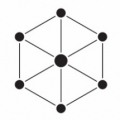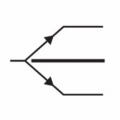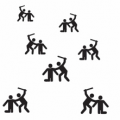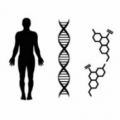Theory of Thought-Shapers
= "Thought-shapers are essentially non-conceptual contents that operate in the construction of mental imagery and thought by arbitrarily picking out some topological and/or processual properties, and subsequently exaggerating or diminishing their presence." [1]
Contextual Quote
1.
"The mechanistic worldview that has desensitized us and prevented us from looking at the world in a fully entangled, organic manner."
2.
All in all, therefore, achieving the special organic meta-cognitive attitude or standpoint of creative piety is a cognitive revolution. So in this way, for genuine progress in human thinking to occur, in any domain—formal-scientific or natural-scientific, applied-artistic or fine-artistic, philosophical, moral, or sociopolitical — we must emancipate ourselves from the mechanistic worldview.
- Robert Hanna and Otto Paans [2]
Description
Thought-Shapers
By Robert Hanna and Otto Paans:
1.
"Thought-shapers include mental representations of allegories, analogies, blueprints, catechisms, diagrams, displays, icons, images, lay-outs, metaphors, mnemonics, models, outlines, parables, pictures, scenarios, schemata, sketches, spreadsheets, stereotypes, symbols, tableaux, and templates. Indeed, Plato’s Cave analogy is especially notable in being not only part of an anticipatory or preliminary theory of thought-shapers, but also being, as an analogy, itself a thought-shaper. More generally, what the philosophers and cognitive scientists mentioned in the just-previous paragraph are telling us, in effect, is that necessarily, all human thinking is inherently shaper-inflected. And not only that. The King James version of the Bible’s Book of John begins, ‘In the beginning was the Word (logos)’. In the early 19th century, Goethe wrote in Faust: ‘In the beginning was the Deed’ (Im Anfang war die Tat). And circa 1945, Wittgenstein wrote: ‘Words are deeds’ (Worte sind Taten). For our purposes in this essay, we’ll take ‘the Word’ and ‘words’ to mean natural language. Then, learning from all of these, and formulating our claim somewhat gnomically, in the style of the King James version and Goethe, ... "
In a nutshell, our claim is:
Our thesis, in turn, entails that all human thoughts are deeds too. Indeed, our theory of thought-shapers falls fully within the broad scope of the first three Es of the contemporary 4E approach to human cognition, by affirming that all human thought is embodied, embedded, and enacted."
(https://cosmosandhistory.org/index.php/journal/article/view/923/1560)
2. Otto Paans and Boukje Ehle:
"Shaping is the term we use for processes that partially (but not wholly) causally determine, dynamically form, and normatively guide our essentially embodied human minds and lives (Maiese and Hanna, 2019).
Thought-shapers are mental representations, especially including analogies, images, schemata, stereotypes, symbols,and templates, that specifically shape our essentially embodied human thinking processes; and the theory of thought-shapers (TTS) about human thinking says that our essentially embodied human thinking processes are either,
(a) shaped negatively by mechanical, constrictive thought-shapers, or
(b) shaped positively by organic, generative thought-shapers (Hanna and Paans, 2021).
Thought-shapers operate pre-consciously and schematically combine essentially non-conceptual and conceptual contents. This feature makes it hard to catch them “at work,” as they shape conscious thought and disposition continuously, while w eare often only intermittently or not at all aware of them. Given the fact that thought-shapers are mental representations with topological and processual properties, we access them primarily through our conative and cognitive attitudes of imagination. The cognitive attitude is successful when the contents of the mind are reflected in the world, that is, when there is a match between what is mentally represented and what is perceptually present. Conversely, the conative attitude is successful when the contents of the world are satisfied in the mind (Kind, 2017a, p. 5;Kind, 2017b). It follows that believing is a paradigmatic cognitive attitude, while desiring is a paradigmatic conative attitude.
In the first case, the belief is justified when it matches a state of affairs in the manifestly real world. In the second case, the desire is feasible when it is directed toward some possible state of affairs that could obtain at some point in time. So, thought-shapers straddle the mind-world connection in both directions, and consequently, influence and orient the domains of belief, desire and intention through imaginative force."
(https://www.academia.edu/83849541/Action_Shapers_and_Their_Neuro_Immunological_Foundations)
Action-Shapers
Otto Paans and Boukje Ehle:
"According to TTS, thought-shapers shape human thinking in various ways, some of which are mechanical and constrictive others of which are organic and generative. Due to their shaping activity, thought-shapers partially (but not wholly) causally determine, effectively direct, guide, influence, and orient the emergence of thoughts. If they did not, TTS would have no real-world impact whatsoever (Hanna and Paans, 2021). The constrictive character of mechanist thought-shapers stems from the fact that an idealized model or point of reference is used to specify, interpret and perceptually color various context-sensitive datums, even when there is no justification for doing so. By contrast, generative thought-shapers function in an opposite manner: [B]y “installing” human thinking in inherently re-configurable and re-patternable “grooves, ”self-consciously unlock, liberate, and sustain creative and productive human thinking. A characteristic feature of generative thought-shapers is that they possess not only effective, true, flexible application to a proper domain of content, but also effective, true, flexible re-application or repurposing ,across several or even unrestrictedly many different domains of content, yet without being infinitely malleable, ambiguous, or vague (Hanna and Paans, 2021, p. 24).
Thought-shapers pre-self-consciously shape thoughts and therefore they also pre-self-consciously shape intentions, desires, beliefs and volitions. But desires can become effective and turn into actions. So, we can say that thought-shapers at some point develop or extend into their action-oriented counterparts that translate desires into real physical actions. We call these action-oriented counterparts action-shapers. Likewise, we call the context-specific operating environment of an action-shaper the action-space. Referring back to the example of Green and Black, even though he’s a human intentional agent with source-incompatibilist free will, Green nevertheless spontaneously effectively desires, chooses, and acts according to some action-shaper within an action-space that partially (but not wholly) causally determines, forms, and normatively guides his arm-raising act. The “partially-but-not-wholly” clause is important. Not all actions are linearly partially caused by action-shapers, just as not all thoughts are linearly partially caused by thought-shapers. Similarly, actions are not completely causally determined by action-shapers, just as thoughts are not completely causally determined by thought-shapers. If we were to hold that view, we would be thrown back into a kind of bleak, deterministic, and mechanistic picture about human agency. Thought-shapers primarily exercise their influence through our capacity for imagination (Hanna and Paans, 2021). By contrast, action-shapers exert their influence primarily via desires, affects or emotions. This is not to say that thought-shapers and action-shapers function in isolation, as naturally, their effects revert into one another. And just as thought-shapers might be closely bound up with passions or emotions, so action-shapers might well involve mental imagery. So, the primary modes of exerting influence differ for both thought-shapers and action-shapers but are not mutually exclusive. A far better way of thinking about both thought- shapers and action-shapers is to regard them as exerting a salient yet non-deterministic influence throughout our representational capacities involved in our self-image and our perception of the world, exercised via the imagination or desires, intentions and affects. In the cases of bad thought-shaping and bad action-shaping, we might imagine them as being like the archetypical malevolent advisor who whispers half-truths and suggestions into a king’s ear. At no point does the advisor literally tell the king what to do, but he definitely directs the course of action that the king will take, without, however, taking away the king’s capacity for free choice. In the cases of good thought-shaping and good action-shaping, we can imagine them as being like the equally archetypal benevolent advisor who offers constructive advice to the king. In an analogous manner, action-shapers do not remove one’s capacity for freely choosing to perform an action or abstaining from doing so, but instead they act as diffuse yet salient causal influences, motivators, detractors, moderating or aggravating forces on the translation from desire into action. A person’s action space is the array of possible actions he or she can perform at T1, given the influential presence of various contextual conditions and weak yet salient causal forces, such as thought-shapers or action-shapers, in play at T1. If we return to the example of Black and Green, we can imagine that Green finds himself originally in a very broad action space. He can lift his arm if he desires to do so, without any constraint. But if Black starts to tamper with Green’s ability to translate desires into actions, orif Black manipulates Green’s preferences to choose option A over option B in similar circumstances, then we can see that the action space of Green is narrowed down, possibly for the worse. And, if we imagine an extreme case, then we can even imagine that Green’s action space is narrowed down to the degree that he has one and only one choice in that context. We must add one important qualifier. As defined above, thought-shapers and action-shapers alike influence the orientation of beliefs, desires and intentions. So, while Green might believe that he cannot raise his arm, he might be actually able to perform that act anyway. But because he does not believe that he can, he abstains from trying. So, while the action-space from Green’s own point of view seems very constrained, objectively it might be much broader than he imagines. Although there are certainly cases where a narrow action-space can be bad, it is worth noting that the opposite is also true: in some cases, a certain focus or single-mindedness can be intensely rewarding, for instance in engaging in creative work. Alternatively, someone who witnesses a swimmer drowning, andchoosestoriskhisownlifebyjumpinginthewaterandsavingtheswimmer might well say that he felt that he “had no other choice, ”although formally he could have walked away. In such cases, the narrowing down of the action-space is a positive feature. Thought-shapers and action-shapers mutually influence each other."
(https://www.academia.edu/83849541/Action_Shapers_and_Their_Neuro_Immunological_Foundations)
The Domino Model
This is the rival theory that TTS is directed to improve upon, by Otto Paans and Boukje Ehle:
"Let’s consider a picture of human intentional action that is — in its many variations — quite widespread since at least the time of Aristotle. We refer to it as “The Domino Model” (TDM). According to TDM, an action is preceded by a decision to take action, which is in turn preceded by a motive or reason for deciding to act (Chisholm, 2013; Reeve, 2018, p. 149). So, TDM takes the form of a causal explanatory chain. When someone is said to desire to raise his arm, we have to explain not just the motives for intending to do so, but also where the motive came from. Answering this question by referring to some primal will or volition does little to shed light on the matter, as the question then becomes what the cause of the primal will actually is."
(https://www.academia.edu/83849541/Action_Shapers_and_Their_Neuro_Immunological_Foundations)
Characteristics
By Robert Hanna and Otto Paans:
"Our argument has seven parts.
First, we propose a nonideal cognitive semantics for thought-shapers that’s grounded on the categorical distinction between conceptual content and essentially non-conceptual content.
Second, we propose a cognitive dynamics for thought-shapers that’s grounded on the essential embodiment theory of the mind-body relation.
Third, we introduce a basic distinction between constrictive thought-shapers and generative thought-shapers.
Fourth, we present some paradigmatic classical examples of constrictive thought-shapers in metaphysics, epistemology and—thereby demonstrating the pervasive influence of thought-shapers — in morality or socio-politics, along with accompanying diagrams.
Fifth, we explain the distinction between constrictive thought-shapers and generative thought-shapers in terms of the categorical difference between mechanical facts and phenomena, and organic facts and phenomena.
Sixth, we explore adverse cognitive effects of mechanical, constrictive thought-shapers.
Seventh and finally, we propose a strategy for acknowledging organic systems and organic, generative thought-shapers: by achieving all or any of the modes of a special organic meta-cognitive attitude or standpoint we call creative piety."
(https://cosmosandhistory.org/index.php/journal/article/view/923/1560)
Discussion
< "In our view, only organicism is a philosophically, scientifically, artistically, morally, and socio-politically fully adequate worldview, and therefore only its root metaphor—the organism — is a fully generative thought-shaper. As a consequence, the root metaphors associated with animism, mysticism, formism, mechanism, and contextualism are all, to some degree, constrictive thought-shapers; and the natural automaton or natural machine, the root metaphor associated with the mechanistic worldview, is the most constrictive." >
Constrictive vs. Generative Thought-Shapers
By Robert Hanna and Otto Paans:
"The theory of thought-shapers is continuous with and an extension of the theory of social-institutional mind-shaping and life-shaping that Michelle Maiese and Robert Hanna presented in their 2019 book, The Mind-Body Politic. In that book, they argue (i) that mind-shaping and life-shaping in human social institutions is essentially embodied and directly revealed in bodily comportment, and (ii) that there’s a crucial distinction between (iia) social institutions that shape our essentially embodied minds/lives in destructive, deforming ways, and (iib) social institutions that shape our essentially embodied minds/lives in constructive, enabling ways, where the difference between destructive, deforming ways and constructive, enabling ways is cashed out in terms of either frustrating and undermining, or else promoting and sustaining, the satisfaction of true human needs.
...
Mirroring and extending Maiese’s and Hanna’s thesis in The Mind-Body Politic, there’s a corresponding basic distinction in our theory of thought-shapers between:
(i) thought-shapers that shape our conceptual thinking in destructive, deforming ways, which we call constrictive thought-shapers, and
(ii) thought-shapers that shape our conceptual thinking in constructive, enabling ways, which we call generative thought-shapers. But what, more precisely, is the difference between constrictive and generative thought-shapers?
A starting point for explaining this difference is that Platonic images, Baconian Idols, Marxian ideology, Wittgensteinian pictures, at least some Pepperian root metaphors for metaphysical worldviews,58 and persistent false beliefs and misinformation, are all vivid examples of constrictive thought-shapers. In this way, constrictive thought-shapers typically ‘install’ and ‘groove’ people’s thinking not only pre-reflectively and non-self-consciously, but also, and above all, by operating essentially as what William Blake called mind-forg’d manacles. ... More specifically, then, constrictive thought-shapers, in a mostly pre-reflective and non-self-conscious way, lock human thinking into false dogmatic assumptions and presuppositions, and into repetitive, uncreative, and unproductive routines, that inevitably lead to contradictions, dilemmas, paradoxes, and vicious circles in philosophical, formal-scientific, and natural-scientific thinking (aka dialetheias),60and to conflicts, crashes, crises, and cul de sacs (aka disasters) in artistic, moral, and sociopolitical thinking.
...
By a diametrically opposed contrast to constrictive thought-shapers, generative thought-shapers, by ‘installing’ human thinking in inherently re-configurable and re-patternable ‘ grooves ’, self-consciously unlock, liberate, and sustain creative and productive human thinking. A characteristic feature of generative thought-shapers is that they possess not only effective, true, flexible application to a proper domain of content, but also effective, true, flexible re-application or repurposing, across several or even unrestrictedly many different domains of content, yet without being infinitely malleable, ambiguous, or vague.
Our view is that
(i) constrictive thought-shapers are inherently mechanical and non-organic in structure, and also inherently computational, hence inherently captured b y Turing-style algorithms and by the Standard Models of particle physics and cosmology, whereas
(ii) generative thought-shapers are inherently non-mechanical and organic in structure, and also inherently non-computational, hence inherently not captured by Turing-computable algorithms, but instead and on the contrary, inherently captured only by complex systems dynamics and organismic evolutionary biology, but also
(iii) mechanicity/ constriction and organicity/generativity in thought-shapers, alike, allow for a range of degrees in each of their occurrences, in the sense that although mechanicity/constriction and organicity/ generativity are strict contraries and mutually exclusive, each of those properties is instantiated or realized to a greater or lesser degree in any given thought-shaper, hence any given thought-shaper can be either more-or-less mechanical/ constrictive or more-or-less organic/generative, although never simultaneously both mechanical/constrictive and also organic/generative.
...
Anything is organic if and only if it’s not a natural mechanism, and has an inherently uncomputable/non-recursiveprocessual, purposive, and self-organizing dynamics that dissipates entropy (i.e., creates negentropy by spontaneously restructuring matter and energy), running from The Big Bang Singularity forward, via temporally asymmetric or unidirectional energy flows, to organismic life, and then on to conscious mind in general and to rational human conscious mind in particular. Correspondingly, our thesis is that there is a single, unbroken metaphysical continuity between The Big Bang Singularity, temporally asymmetric/unidirectional energy flows, organismic life, conscious mind in general, and rational human conscious mind in particular, and that anything inherently belonging to this continuity is organic in structure, especially including human thinking that’s at least partially caused, normatively guided, and contextually enabled by generative thought-shapers.
Constrictive thought-shapers generally presuppose what we’ll call the mechanistic worldview, according to which everything whatsoever in the world, including all human activity, is fully and ultimately explicable by mechanical principles alone (including principles of computability and/or mathematical physics, including chemistry, and biology insofar as it is reducible to physics and chemistry).
In turn, and more specifically, the mechanistic worldview consists in the conjunction of three somewhat distinct but logically nested theses:
(i) formal mechanism, applied to mathematics, logic, truth, and knowledge more generally, namely the theory of computability and recursive functions, including decidability,80
(ii) natural mechanism, which applies the notion of a natural automaton or natural machine, as per the description immediately above, to everything in the material or physical world,81 and
(iii) scientific naturalism, applied to everything in the world, including all human activity, which includes formal and natural mechanism, scientism (i.e., the valorization of the formal and/or natural sciences and their methods), empiricism, and materialist/ physicalist metaphysics (i.e., everything in the world is either identical to or necessarily dependent on fundamentally physical contingent facts).82 Of course, the root metaphor for the mechanistic worldview is the natural automaton or naturalmachine.
By another diametric oppositional contrast, generative thought-shapers generally presuppose what we’ll call the organicist worldview.
Correspondingly, and consistently with that, by an organism we mean an inherently uncomputable/non-recursive processual, purposive, and self-organizing entity with any of the basic features listed in the three-part OEED definition.
The Oxford Encyclopedic English Dictionary defines ‘organism’ as follows:
- a living individual consisting of a single cell or of a group of interdependent parts sharing the life processes.
- an individual live plant or animal.
- the material structure of this.
- a whole with interdependent parts compared to a living being
According to the organicist worldview, everything whatsoever in the manifestly real world, including ourselves, is either
(i) a simple or complexorganism, or
(ii) a society of organisms, or
(iii) a proper part of an organism or a society of organisms, or
(iv) an immanent or intrinsic structural property of an organism or society of organisms, or (v) a causal product or byproduct of an organism or society of organisms, or
(vi) necessarily dependent on (i.e., either naturally/ nomologically or logically strongly supervenient on) an organism or a society of organisms, or
(vii) ecosystemic or proto-organismic in that it belongs to the set of actual conditions under which an organism or society of organisms emerges or operates, or
(viii) inherently analogous or homologous to an organism or society of organisms.
Obviously, the root metaphor for the organicist worldview is the organism.
...
Here’s an extremely important further point about the diametric oppositional contrast we’ve been developing between mechanical, constrictive thought-shapers and organic, generative thought-shapers. In principle, there’s absolutely nothing bad, false, or wrong with applying mechanical thought-shapers to inherently mechanical facts.
But when inherently mechanical, recursive thought-shapers, in economics, social theory, or political theory—for example, Prisoner’s Dilemma matrices, as a core thought-shaper in game theory — are systematically misapplied to inherently complex, organic real-world moral and sociopolitical facts and decision-making, then real-world conflicts, crashes, crises, and cul de sacs—real-world disasters—result in and through the corresponding shaped thoughts: namely, bad, false, and wrong ideological beliefs. A paradigmatic recent example of this is Garrett Hardin’s spectacularly influential 1968 essay, ‘The Tragedy of the Commons’.
...
In other words, the real tragedy of the commons is how Hardin’s spectacularly wrongheaded argument in ‘The Tragedy of the Commons’ has operated in morality and sociopolitics since the late 1960s, worldwide, as a spectacularly disastrous mechanical, constrictive thought-shaper.
Again, the problem lies not in the mechanical, recursive structure of the thought-shaper per se and its corresponding mechanical, recursive shaped thoughts itself—no doubt, Prisoner’s Dilemma matrices and game theory fairly accurately capture the behavior of people playing Monopoly, Risk, video games, online poker, cruising the casinos at Las Vegas, or engaged in gambling more generally — but instead in its altogether bad, false, and wrong misapplication to the nonideal organic complexities of ‘human, all-too-human’ moral and sociopolitical free agency ‘in the wild’, in the larger manifestly real world."
(https://cosmosandhistory.org/index.php/journal/article/view/923/1560)
A Plea for Developing Creative Piety
By Robert Hanna and Otto Paans:
"In a closely related way, in the late 18th and 19th century, Goethe (especially in The Metamorphosis of Plants), the British Romantic poets, Henry David Thoreau, and the Impressionists all made the excellent point that being truly able to see what already lies right before one’s eyes in the fundamentally organic cosmos requires a special kind of cognitive humility, cognitive openness, and cognitive self-discipline: for example, resolving to live self-reliantly and simply, in the woods beside Walden Pond. Wordsworth, Shelley, and the early 20th century British philosopher Samuel Alexander aptly call that special cognitive attitude or standpoint natural piety.
...
There’s an analogous, parallel phenomenon in the formal sciences — exemplified, for example, by Cantor’s mathematics of transfinite or ‘transcendental’ numbers, which bears witness to higher-dimensional infinities, by Gödel’s incompleteness theorems, which bear witness to the inherently non-logical character of mathematical truth, and by Tarski’s semantic conception of truth, which bears witness to Gödel-incompleteness and the Liar Paradox alike — that we’ll call formal piety.
Again, there’s another analogous, parallel phenomenon in the social sciences and political anthropology — exemplified, for example, by Wilhelm Dilthey’s notion of Verstehen, by what Wittgenstein calls ‘agreement (Übereinstimmung) ... in form of life (Lebensform) ’, and by what James C. Scott calls metis — that we’ll call social piety.
Similarly, there’s another analogous, parallel phenomenon in moral theory and ethics — exemplified by Kant’s notion of respect for human dignity — that we’ll call moral piety.
And finally, the correlate of all these in organicist metaphysics is what we’ll call metaphysical piety. For convenience, and to distinguish all these modes of piety sharply from religious piety — which (to mix metaphors) is a horse of a different color and a different kettle of fish — we’ll group them under the general term creative piety.
Creative piety is bearing witness to the essentially rich structures of organic formal systems, organic cosmological systems, organic social systems, organic moral and ethical systems, and organic metaphysical systems.
An essential feature of creative piety, in every one of its modes, is that it inherently involves taking a critical, reflective standpoint on some or another determinate domain of content, a standpoint that’s at once
(i) higher-dimensional—for example, generating a ‘transcendental’ third-dimensional point-of-view out of an array or spreadsheet of that content that’s otherwise merely ‘flat’ or two-dimensional,
(ii) synoptic with respect to the entire determinate domain of content—for example, seeing a landscape as a dynamic three-dimensional contour map from the vantage point of an airplane flying over it, and also
(iii) fully critical cognizant of the inherent boundaries or limits of that determinate domain of content—for example, its Gödel-incompleteness or Tarski-irreflexivity with respect to logico-mathematical truth, truth-definitions, or alethic self.
...
Just to give this standpoint a handy label, let’s call it organic meta-cognition. An important emergent feature of organic meta-cognition is that even though, as per element (iii), it always involves a critical recognition of the inherent boundaries or limits of some determinate domain of content, nevertheless, in view of elements (i) and (ii), it also yields a new kind of creatively unbounded or unlimited cognition of that bounded or limited determinate domain.
...
For these reasons, organic meta-cognition via creative piety should be sharply distinguished from the merely Turing-computable, recursive, rote generation of higher-order levels of content from lower-order levels of content, that we’ll call mechanical meta-cognition—for example, Russell’s theory of types..
All in all, therefore, achieving the special organic meta-cognitive attitude or standpoint of creative piety is a cognitive revolution. So in this way, for genuine progress in human thinking to occur, in any domainn—nformal-scientific or natural-scientific, applied-artistic or fine-artistic, philosophical, moral, or sociopolitical — we must emancipate ourselves from the mechanistic worldview.
(https://cosmosandhistory.org/index.php/journal/article/view/923/1560)
From the Conclusion
By Robert Hanna and Otto Paans:
"In the 19th century, Flaubert wrote brilliantly and scathingly about sentimental education, faintly and ironically echoing Kant’s concept of a moral catechism. But what we all need to do here and now, during the long roll-out and even longer fall-out of the 2020-2021 COVID-19 pandemic, is to replace the inherently destructive and deforming current global system of mechanical, constrictive thought-drills, by designing and dynamically implementing a new and inherently constructive and enabling global system of organic, generative thought-skills. Such a new thought-system, communicated, disseminated, and inculcated by a correspondingly new global system of social institutions, would essentially consist in effectively priming, evoking, and sustaining the special organic meta-cognitive attitude or standpoint of creative piety.
...
We strongly believe that in a world dominated and pervaded by the mechanistic worldview and mechanical, constrictive thinking, it’s all up to humanity to engage consistently, resolutely, and wholeheartedly in organic, generative thinking, for ourselves, by globally acknowledging and enacting organic systems and organic, generative thought-shapers and their corresponding shaped thoughts in the form of good, true, and right beliefs, whether in the formal sciences, natural sciences, applied arts, fine arts, philosophy, morality, or sociopolitics. For otherwise, if we fail to do this, then not only metaphorically but also quite literally, it’s The End of the World."
(https://cosmosandhistory.org/index.php/journal/article/view/923/1560)
Visualizations
Some paradigmatic classical philosophical constrictive thought-shapers and moral or sociopolitical constrictive thought-shapers
(By Robert Hanna and Otto Paans)
List of previous theories
By Robert Hanna and Otto Paans:
"Anticipations or preliminary versions
- Plato’s theory of ‘images’ or eikones, as presented in his famous analogy of The Cave in the Republic,
- A. Silverman, ‘Plato's Middle Period Metaphysics and Epistemology’, in E.N. Zalta (ed.), The Stanford Encyclopedia of Philosophy (Fall 2014 Edition), available online at URL = <https://plato.stanford.edu/archives/fall2014/entries/plato-metaphysics/>
- Bacon’s theory of ‘Idols which beset men’s minds’ in The Novum Organum,
- F. Bacon, ‘The Four Idols’, Sophia Project (2021), available online at URL = <http://www.sophia-project.org/uploads/1/3/9/5/13955288/bacon_idols.pdf>
- Hegel’s work on the ‘movement of the Notion’,
- G.W.F. Hegel, Phenomenology of Spirit, trans. A.V. Miller, Oxford, Oxford Univ. Press, 1979
- Marx’s theory of ideology in The German Ideology and other works,
- J. Wolff and D. Leopold, ‘Karl Marx’, in E.N. Zalta (ed.), The Stanford Encyclopedia of Philosophy(Spring 2021 Edition), available online at URL= <https://plato.stanford.edu/archives/spr2021/entries/marx/>, esp. section 6, at sub-URL = <https://plato.stanford.edu/entries/marx/#Ideo>
- Gaston Bachelard’s work on ‘the dialectics of inside and outside’,
- G. Bachelard, The Poetics of Space, trans. M. Jolas, Boston, Beacon Press, 1969
- Stephen Pepper’s work on ‘root metaphors’ in metaphysics,
- S.C. Pepper, World Hypotheses, Berkeley and Los Angeles, CA, Univ. of California Press, 1942, esp. ch V
- Gilles Deleuze’s work on the ‘image of thought’,
- G. Deleuze, Difference and Repetition, 2nd edn., London, Bloomsbury, 2014
- Hans Blumenberg’s work on prefiguration,
- A. Nicholls and F. Heidenreich (eds.), H. Blumbenberg, Präfiguration: Arbeit am Politischen Mythos, Berlin, Suhrkamp, 2014.
- Jacques Ranciére’s work on political aesthetics,
- J. Rancière, Dissensus: On Politics and Aesthetics, trans. S. Corcoran, London, Continuum, 2010
- Otto Neurath’s ISOTYPE theory,
- O. Neurath, International Picture Language. First Rules of Isotype, London, Kegan Paul, Trench, Trubnerand Co., 1936
- Wittgenstein’s theory of linguistically-transmitted ‘pictures’ or Bilder and how they entrap philosophical thinking,
- Wittgenstein, Philosophical Investigations (as per the epigraphs at the head of our essay), §§114-115, p. 48e, and §139, p. 54
- Philip Johnson-Laird’s work on ‘mental models’, when taken together with that of other leading ‘depictivists’ — especially Roger Shepard and Stephen Kosslyn — in the late 20th century debate about mental imagery in cognitive neuroscience. ("The debate about mental imagery was between the depictivists, who held that the representational content of images is essentially non-conceptual, and the propositionalists, who held that the representational content of images is essentially conceptual.")
- R. Shepard and S. Chipman, ‘Second Order Isomorphisms of Internal Representations: Shapes of States’, Cognitive Psychology, 1, 1970, pp. 1-17; R. Shepard and J. Metzler, ‘Mental Rotation of Three-Dimensional Objects’, Science, 171, 1971, pp. 701-703; R. Shepard, ‘The Mental Image’, American Psychologist, 33, 1978, pp. 125-137; S. Kosslyn, Image and Mind, Cambridge, MA, Harvard Univ. Press, 1980; R. Shepard and L. Cooper, Mental Images and their Transformations, Cambridge, MA, MIT Press, 1982; P. Johnson-Laird, Mental Models, Cambridge, MA, Harvard Univ. Press, 1983; and S. Kosslyn, Image and Brain, Cambridge, MA, Harvard Univ. Press, 1994."
(https://cosmosandhistory.org/index.php/journal/article/view/923/1560)
Non-Western Sources: Japanese Thought That Emphasizes a Qualified Form of Seeing
By Robert Hanna and Otto Paans:
"We can also find a long tradition in Japanese thought that emphasizes a ‘qualified form of seeing’.
For example, it’s salient in Nishi Amane’s philosophical aesthetics, in Ōnishi Yoshinori’s account of the notion of aware,115and also later on in the work of Kitarō Nishida. Notably, Nishida based an important tenet of his philosophy of the notion of ‘pure experience’116 and later on, developed it into the notion of ‘object logic’. Concisely put, according to Nishida we erroneously revert to an ‘object logic’ or fragmented world-picture once we suppress or deform our innate abilities for real seeing. Thinking about discrete, manipulable objects leads, according to Nishida, to a distorted world hypothesis—or distorted root-metaphor—about how the world actually functions. This distortion stems from the fact that we’ve turned our back on our abilities to comprehend the world as a unity.
Notes:
- Aware’ is the Japanese word for a special kind of aesthetic perception. Although it’s a homonym of the English term ‘aware’, and even overlaps in meaning with the English word slightly, it expresses an importantly different concept.
- Nishida borrowed and adapted the notion of ‘pure experience’ from William James, and it forms the backbone of much of his early thinking, although he also refined and reworked it over the years. See, e.g., K. Nishida, An Inquiry Into the Good, trans. C. Ives and A. Masao, New Haven, CT, Yale Univ. Press, 1990, pp. 3–10. See also W. James, ‘A World of Pure Experience’, Journal of Philosophy, Psychology and Scientific Methods, 1, 1904, pp. 533–543.
- Nishida’s views on ‘object logic’ are presented in K. Nishida, Last Writings: Nothingness and the Religious Worldview, Honolulu, HI, Univ. of Hawaii Press, 1993.118 J. W. Heisig, Much Ado About Nothingness: Essays on Nishida and Tanabe, Nayoga, Chisokudō Publications, 2016, p. 17.
(https://cosmosandhistory.org/index.php/journal/article/view/923/1560)
More information
- For related conceptions, see also:
- Religious Ground Motives Behind Human Thought, by Herman Dooyeweerd (i.e. Transcendental Pragmatism)
- The Root Metaphor Theory in the Fourfold World Hypotheses Model of Stephen Pepper which distinguishes Formism (similarity), Mechanism (machine), Contextualism (historical act) and Organicism (living system)
- "Recent work in cognitive psychology and social psychology on the persistence of false belief or misinformation and the ‘backfire effect’ ."
- B. Nyhan and J. Reifler, ‘When Corrections Fail: The Persistence of Political Misperceptions’, Journal of Political Behavior, 32, 2010, pp. 303-330, available online at URL = <https://www.unc.edu/~fbaum/teaching/articles/PolBehavior-2010-Nyhan.pdf; and
- S. Lewandowsky et al., ‘Misinformation and Its Correction: Continued Influence and Successful Debiasing’, Psychological Science in the Public Interest, 13, 2012, pp. 106-131, available online at URL = <https://dornsife.usc.edu/assets/sites/780/docs/12_pspi_lewandowsky_et_al_misinformation.pdf>
Connect with the authors via:
- Robert Hanna <bobhannahbob1@gmail.com>
- Otto Paans <ocpaans@gmail.com>
Bibliography
- Hanna, R., ‘Beyond the Myth of the Myth: A Kantian Theory of Non-Conceptual Content’, International Journal of Philosophical Studies, 19, 2011, pp. 321–396.
- Hanna, R., ‘Can Physics Explain Physics? Anthropic Principles and Transcendental Idealism’, in L. Caranti (ed.), Kant and The Problem of Knowledge in the Contemporary Wo r l d, London, Routledge, forthcoming, also available online in preview at
- Hanna, R., Cognition, Content, and the A Priori: A Study in the Philosophy of Mind and Knowledge, THE RATIONAL HUMAN CONDITION, Vol. 5, Oxford, Oxford Univ. Press, 2015, also available online in preview at
- Hanna, R., ‘The Debate About Non-Conceptual Content Revisited: On Corijn van Mazijk’s Perception and Reality in Kant, Husserl, and McDowell’, International Journal of Philosophical Studies, 29, 2021, pp. 90-115, available online at URL = <https://www.tandfonline.com/doi/abs/10.1080/09672559.2021.1873543>, and also in preview at
- Hanna, R., Deep Freedom and Real Persons: A Study in Metaphysics, THE RATIONAL HUMAN CONDITION, Vol. 2, New York, Nova Science, 2018, also available online in preview at
- Hanna, R., ‘The Essential Non-Conceptuality of the Imagination’, Contemporary Studies in Kantian Philosophy5 (2020): 53-72, available online at
- Hanna, R., FROM COSMOLOGY TO DIGNITY: A Theory of Life, the Universe, and Everything, Unpublished MS, 2021,available online at
- Hanna, R., ‘Kant, the Copernican Devolution, and Real Metaphysics’, in M. Altman(ed.), Kant Handbook, London, Palgrave Macmillan, 2017, pp. 761-789.
- Hanna, R., Kantian Ethics and Human Existence: A Study in Moral Philosophy, THE RATIONAL HUMAN CONDITION, Vol. 2, New York, Nova Science, 2018, also available online in preview at
- Hanna, R., ‘Kant, Radical Agnosticism, and Methodological Eliminativism about Things-in-Themselves’, Contemporary Studies in Kantian Philosophy, 2, 2017, available online at
- Hanna, R., ‘Memory, “Alternative Facts”, and the Political Philosophy of Cognition’, Borderless Philosophy, 1, 2018, available online at
- Hanna, R., ‘Minding the Body’, Philosophical Topics, 39, 2011, pp. 15-40, also available online in
- Hanna, R., ‘The New Conflict of the Faculties: Kant, Radical Enlightenment, The Hyper-State, and How to Philosophize During a Pandemic’, Con-Textos Kantianos, 11, 2021, forthcoming, also available online in preview at
- Hanna, R., ‘On Rutger Bregman’s Humankind: Optimism For Realists, Or, Neither Hobbes Nor Rousseau’, Unpublished MS, 2020, available online at
- URL = <https://www.academia.edu/43631182/On_Rutger_Bregmans_Humankind_Minor_revisions_22_September_2020_>.
- Hanna, R., Rationality and Logic, Cambridge, MA, MIT Press, 2006.
- Hanna, R., ‘Sensibility First: How to Interpret Kant’s Theoretical and Practical Philos o p h y ’, Estudos Kantianos, 2021, forthcoming, available online in preview at
- Hanna, R., ‘What is the Nature of Inference?’, in V. Hösle (ed.), Forms of Truth, Notre Dame, IN, Univ. of Notre Dame Press, 2014, pp. 89-101.
- Hanna, R., ‘Zero for Conduct at The Pittsburgh School: Three Dogmas and ThreeRadical Kantian Alternatives’, in A. Cicatello, A. Di Riccio, and D. Manca (eds.), The Metaphysics of The Pittsburgh School and its Kantian Lega cy, forthcoming, also available online in preview at
- Hanna, R. and Maiese, M., Embodied Minds in Action, Oxford, Oxford Univ. Press, 2009.
- Hanna, R. and Paans, O., ‘This is the Way the World Ends: A Philosophy of Civilization Since 1900, and A Philosophy of the Future’, Cosmos & History, 16, 2, 2020, pp. 1-53, available online at
- URL = <http://cosmosandhistory.org/index.php/journal/article/viewFile/865/1510>, and also available online in preview at
- URL = <https://www.academia.edu/42823697/This_is_the_Way_the_World_Ends_A_Philosophy_of_Civilization_Since_1900_and_A_Philosophy_of_the_Future_Co_authored_with_Otto_Paans_Published_version_in_Cosmos_and_History_16_2_2020_1_53_>.
- Paans, O., ‘The Imaginative Spectrum: Kantian Imagination and Nonconceptual/ Conceptual Interactions’, Contemporary Studies in Kantian Philosophy, 5, 2020, pp. 95–115.
- Paans, O. and Pasel, R., ‘The Simulative Stance: Architectural Design as Epistemic Enactment’, in R. Christensen, E. Drach, L. Gasperoni, D. Hallama, A. Hougaard, and R. Liptau (eds.), Artefakte des Entwerfens: Skizzieren, Zeichnen, Skripten, Modellieren, Berlin, Universitätsverlag der TU Berlin, 2020, pp. 58–74
Source
* Article: Thought-Shapers. By Robert Hanna and Otto Paans. Cosmos and History: The Journal of Natural and Social Philosophy, vol. 17, no. 1, 2021.
URL = https://cosmosandhistory.org/index.php/journal/article/view/923/1560
This is a companion-piece to our recent essay, “This is the Way the World Ends: A Philosophy of Civilization Since 1900, and A Philosophy of the Future,” Cosmos & History16, 2 (2020): 1-53.
Abstract:
" In this essay, we shift our focus from the philosophy of human civilization to the philosophy of human thinking.
More precisely, we apply the categorical distinction between
(i) mechanical (i.e., computable/recursive, entropic, and deterministic or indeterministic) systems and
(ii) organic (i.e., uncomputable/non-recursive, processual, negentropic, purposive, and self-organizing) systems, to fundamental issues in the philosophy of mind and cognition, with general application to the nature of human thinking in the formal and natural sciences, the applied arts and fine arts, morality, and sociopolitics, as well as metaphysics and epistemology.
By “thought-shapers,” we mean mental representations of any or all of the following: allegories, analogies, blueprints, catechisms, diagrams, displays, icons, images, lay-outs, metaphors, mnemonics, models, outlines, parables, pictures, scenarios, schemata, sketches, spreadsheets, stereotypes, symbols, tableaux, and templates.
Correspondingly, we argue that human thinking is really possible only insofar as it’s partially causally determined, formed, and normatively guided by either
(i) mechanical, constrictive thought-shapers in a bad, false, and wrong way, or
(ii) organic, generative thought-shapers in a good, true, and right way."










